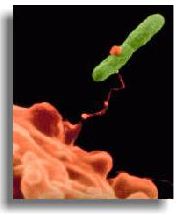 Legionella Pneumophila is a Gram-negative bacterium that is widely distributed in natural and manmade freshwater habitats. All members of the genus have small, rod-shaped cells 1-2 µm in length and 0.5 µm wide and require iron and cysteine for isolation. They will initiate growth on artificial media only over a narrow pH range of 6.8-7.0 but can tolerate a pH range from 5.5-9.0 in natural habitats.
Legionella Pneumophila is a Gram-negative bacterium that is widely distributed in natural and manmade freshwater habitats. All members of the genus have small, rod-shaped cells 1-2 µm in length and 0.5 µm wide and require iron and cysteine for isolation. They will initiate growth on artificial media only over a narrow pH range of 6.8-7.0 but can tolerate a pH range from 5.5-9.0 in natural habitats.
When Legionella Pneumophila was first isolated, it was found to be only distantly related to other bacteria and was placed in its own family, the Legionellaceae. DNA-DNA hybridization experiments and 16S rRNA studies have shown that the species of Legionella are closely related to one another but distantly related to other bacteria. The most closely related groups are the purple sulphur bacteria, the Enterobacteriaceae and Pseudomonas.
Legionella Pneumophila was identified in 1979 following an outbreak of ‘Legionnaire’s Disease’ caused by the bacterium. It was later learned that previous outbreaks of Legionnaire’s disease had occurred as early as 1957. Legionella Pneumophila was isolated in 1947 in a guinea pig that had been inoculated with blood from a patient with an unknown disease.
The first identified outbreak of Legionnaires Disease occurred during a Pennsylvania State Convention of the American Legion in 1976. 182 cases resulted in 29 deaths within the hotel. 38 cases were reported amongst passers by, resulting in a further 5 deaths. In recent years 200 – 300 cases of the disease have been reported each year in England and Wales. The majority of outbreaks are associated with buildings such as; Hotels, Factories, Hospitals, Nursing Homes and Office Blocks.
More research has been carried out in the United States where, according to the OSHA (Occupational Safety and Health Administration – part of the U.S. department of Labour), Legionnaire’s disease is considered to be fairly common and serious, and the Legionella organism is one of the top three causes of sporadic, community-acquired pneumonia.
Because it is difficult to distinguish this disease from other forms of pneumonia, many cases go unreported. Approximately 1,000 cases are reported annually to the CDC (Centre for Disease Control and Prevention), but it is estimated that over 25,000 cases of the illness occur each year and cause more than 4,000 deaths.
This is in excess of 25 times the number of reported cases, which would indicate that some 5000 – 7500 cases in England and Wales is, perhaps, a more accurate figure. There are sources in the UK that believe the true problem attributable to all of the 20+ different varieties of Legionella linked with human diseases, could be significantly higher than this.
In the UK 180,000 people die from all of the different varieties of pneumonia each year. As many cases apply to people in susceptible groups (such as the elderly, smokers, alcoholics, cancer sufferers and other immuno-suppressed patients) rarely is a full investigation of the true cause of the pneumonia carried out.
How do people contract Legionella? The most popular theory is that the organism is aerosolised in water and people inhale the droplets containing Legionella. However, new evidence suggests that there is another way of contracting Legionella. It appears that “aspiration” may be the way the bacterium enters into the lungs. Aspiration means choking such that secretions in the mouth get past the choking reflexes and instead of going into the oesophagus and stomach, mistakenly, enter the lung.